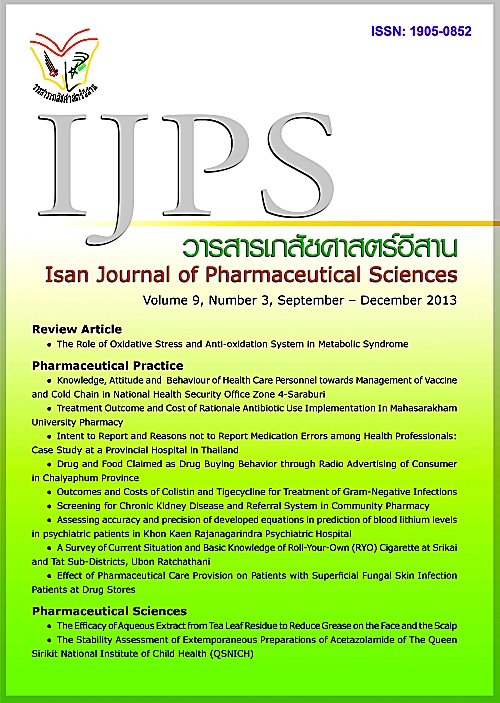The Stability Assessment of Extemporaneous Preparations of Acetazolamide of The Queen Sirikit National Institute of Child Health (QSNICH)
Main Article Content
Abstract
Introduction: The study determined physical and chemical stability of extemporaneous preparations of acetazolamide suspension (10 mg/ml) in light-resistant containers. Materials and Methods: All acetazolamide suspensions were randomly sampled and stored at refrigerated temperature (2-8°C), room temperature (25-28°C) or accelerated temperature (45°C). The changes in physical characteristics such as color and reversible precipitation of suspensions were determined. The chemical characteristics were measured by pH value and the remaining drug contents analyzed using reversed phase HPLC at 0, 7, 14, 21, 28 and 42 days. The acceptable range of remaining drug content was 90-110% of the initial content. Results: It was found that physical characteristics and pH of extemporaneous preparations of acetazolamide were unchanged at all conditions on keeping for 42 days. Drug contents remaining at room temperature (25-28°C) and refrigerated temperature (2-8°C) were in the acceptable range through to 42 days. At accelerated temperature (45°C), drug remaining in all suspensions was in the acceptable range for 28 days and then decreased less than 90% of the initial content. Conclusion: The extemporaneous preparations of acetazolamide can be kept at room temperature (25-28°C) or refrigerated temperature (2-8°C) in light-resistant containers for at least 42 days with no significant change.
Article Details
In the case that some parts are used by others The author must Confirm that obtaining permission to use some of the original authors. And must attach evidence That the permission has been included
References
Alexander KS, Haribhakti RP, Parker GA. Stability of acetazolamide in suspension compounded from tablets. Am J Hosp Pharm 1991; 48: 1241-1244.
Allen LV, Erickson MA. Stability of acetazolamide, allopurinol, azathioprine, clonazepam, and flucytosine in extemporaneously compounded oral liquids. Am J Health-Syst Pharm 1996; 53: 1944-1949.
Batzdorf U. The management of cerebral edema in pediatric practice. Pediatrics 1976; 58: 78-88.
International Conference on Harmonisation (ICH) expert working group. ICH harmonized tripartite guideline. Validation of analytical procedures: text and methodology Q2(R1). Commission of the European Communities; 1996.
Joungmunkong Z, Na-Ranong S, Rakrod S, Ornlaor S, Sila-on W. Accelerated stability testing of extemporaneous suspensions and reconstituted powder for suspensions of acetazolamide and furosemide. IJPS 2013; 9(1): 32-39.
Parasrampuria J, Das GV. Preformulation Studies of acetazolamide: effect of pH, two buffer species, ionic strength and temperature of its stability. J Pharm Sci 1989; 78: 855-857.
Sabri K, Levin AV. The additive effect of topical dorzolamide and systemic acetazolamide in pediatric glaucoma. J AAPOS 2006; 10(5): 464-468.
The United States Pharmacopoeia 31 and National Formulary 26. Acetazolamide oral suspensions (Revision Bulletin) [online] 2008 [cited 2013 Mar 7]. Available from: https://www.usp.org/sites/default/files/usp_pdf/EN/USPNF/acetazolamideOralSuspension.pdf.


